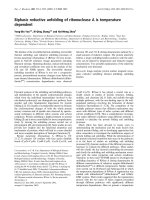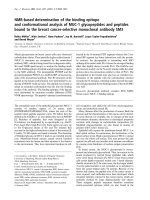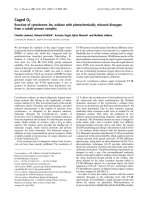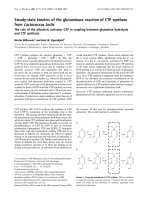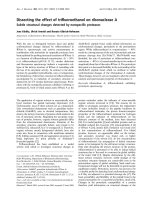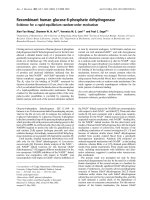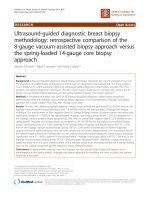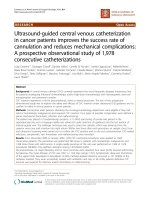Báo cáo y học: "Ultrasound guided injection of dexamethasone versus placebo for treatment of plantar fasciitis: protocol for a randomised controlled trial" potx
Bạn đang xem bản rút gọn của tài liệu. Xem và tải ngay bản đầy đủ của tài liệu tại đây (867.81 KB, 8 trang )
JOURNAL OF FOOT
AND ANKLE RESEARCH
McMillan et al. Journal of Foot and Ankle Research 2010, 3:15
/>Open Access
STUDY PROTOCOL
© 2010 McMillan et al; licensee BioMed Central Ltd. This is an Open Access article distributed under the terms of the Creative Commons
Attribution License ( which permits unrestricted use, distribution, and reproduction in
any medium, provided the original work is properly cited.
Study protocol
Ultrasound guided injection of dexamethasone
versus placebo for treatment of plantar fasciitis:
protocol for a randomised controlled trial
Andrew M McMillan*
1,2
, Karl B Landorf
1,2
, Mark F Gilheany
1,2
, Adam R Bird
1,2
, Adam D Morrow
1,2
and Hylton B Menz
2
Abstract
Background: Plantar fasciitis is the most commonly reported cause of chronic pain beneath the heel. Management of
this condition commonly involves the use of corticosteroid injection in cases where less invasive treatments have
failed. However, despite widespread use, only two randomised trials have tested the effect of this treatment in
comparison to placebo. These trials currently offer the best available evidence by which to guide clinical practice,
though both were limited by methodological issues such as insufficient statistical power. Therefore, the aim of this
randomised trial is to compare the effect of ultrasound-guided corticosteroid injection versus placebo for treatment of
plantar fasciitis.
Methods: The trial will be conducted at the La Trobe University Podiatry Clinic and will recruit 80 community-dwelling
participants. Diagnostic ultrasound will be used to diagnose plantar fasciitis and participants will be required to meet a
range of selection criteria. Participants will be randomly allocated to one of two treatment arms: (i) ultrasound-guided
injection of the plantar fascia with 1 mL of 4 mg/mL dexamethasone sodium phosphate (experimental group), or (ii)
ultrasound-guided injection of the plantar fascia with 1 mL normal saline (control group). Blinding will be applied to
participants and the investigator performing procedures, measuring outcomes and analysing data. Primary outcomes
will be pain measured by the Foot Health Status Questionnaire and plantar fascia thickness measured by ultrasound at
4, 8 and 12 weeks. All data analyses will be conducted on an intention-to-treat basis.
Conclusion: This will be a randomised trial investigating the effect of dexamethasone injection on pre-specified
treatment outcomes in people with plantar fasciitis. Within the parameters of this protocol, the trial findings will be
used to make evidence-based recommendations regarding the use of corticosteroid injection for treatment of this
condition.
Trial Registration: Australian New Zealand Clinical Trials Registry. ACTRN12610000239066.
Background
Plantar fasciitis is the most commonly reported cause of
chronic pain beneath the heel [1,2]. The condition is
characterised by pain at the calcaneal origin of the plan-
tar fascia, made worse by weight-bearing after prolonged
periods of rest [1]. The epidemiology of plantar fasciitis
in the general population is currently uncertain. An Aus-
tralian population-based study involving 3,206 randomly
selected participants has reported a heel pain prevalence
of 3.6% [3]. A North American study of adults aged over
65 years found that 7% had tenderness beneath the heel
[4]. It has also been estimated that 1 million physician vis-
its per year in the United States are for the diagnosis and
treatment of plantar fasciitis [5]. In addition, the disorder
is estimated to account for approximately 8% of all run-
ning-related injuries [6,7].
The underlying pathology of plantar fasciitis is poorly
understood, though the majority of histological studies
report a predominance of degenerative changes at the
plantar fascia enthesis. The most common pathological
features are deterioration of collagen fibres, increased
secretion of ground substance proteins, focal areas of
fibroblast proliferation and increased vascularity [8-11].
* Correspondence:
1
Department of Podiatry, Faculty of Health Sciences, La Trobe University,
Victoria, Australia
Full list of author information is available at the end of the article
McMillan et al. Journal of Foot and Ankle Research 2010, 3:15
/>Page 2 of 8
The presence of biochemical markers of inflammation
(e.g. cytokines and prostaglandins) have not been well
investigated, however, several studies report non-specific
evidence of local inflammatory change [11-13]. As
described in relation to tendinopathy [14], it is feasible
that plantar fasciitis is a disorder that proceeds through a
spectrum of underlying processes. However, evidence for
histological change over time is currently lacking, as cur-
rent studies have only examined specimens obtained
from patients undergoing surgery for long-standing
symptoms. Therefore, the underlying pathology occur-
ring early in the development of plantar fasciitis is cur-
rently unknown.
Plantar fasciitis is commonly described in the literature
as a self-limiting condition [1,2]. This view is supported
by the findings of a systematic review, in which plantar
heel pain was found to resolve over time regardless of
treatment type (including placebo) [15]. Nonetheless,
plantar fasciitis can be a very painful and disabling condi-
tion prior to resolution of symptoms, causing a negative
impact on health-related quality of life [16].
Many interventions are used for the management of
plantar fasciitis [17] and corticosteroid injection is a com-
mon choice among clinicians. Surveys of American podi-
atrists [18] and orthopaedic surgeons [19] have reported
that approximately 75% of respondents used and/or rec-
ommended this intervention. In addition, a systematic
review found that corticosteroid injection is the second
most frequently described treatment for plantar fasciitis
in the medical literature [20].
Despite the widespread use of corticosteroid injection
for plantar fasciitis, only two randomised controlled trials
have tested the effect of this treatment in comparison to
placebo injection [21,22]. By using placebo solution as a
comparator, these trials were able to control for potential
treatment benefits not due to the pharmacological action
of corticosteroids. One trial compared the effect of 25 mg
prednisolone mixed with lignocaine versus lignocaine
alone (placebo), and found a significant difference in pain
reduction favouring corticosteroid one month after treat-
ment [22]. No significant differences between groups
were detected in this trial at either three or six months
after treatment. However, a large proportion of partici-
pants were lost to follow-up, so the authors were unable
to make conclusions regarding corticosteroid efficacy in
the longer term. An earlier trial compared the effect of 25
mg hydrocortisone versus normal saline (placebo), and
found no significant difference in pain reduction between
groups two months after treatment [21]. However, this
trial had a very small sample size (19 participants) and
was therefore statistically underpowered to detect clini-
cally worthwhile differences.
The use of ultrasound in clinical practice has become
increasingly popular due to decreased equipment costs,
and the ability to perform invasive procedures with better
targeting of anatomical structures [23]. Other advantages
include the production of high resolution images without
exposure to ionizing radiation, and the ability to assess
tissues with real-time dynamics [23]. Furthermore, in the
treatment of plantar fasciitis, corticosteroid injection per-
formed with ultrasound guidance has been shown to pro-
duce longer lasting pain relief than injection guided by
palpation [24].
The findings of existing clinical trials provide some
support for the use of corticosteroid injection in the
short-term management of plantar fasciitis [1,15]. How-
ever, a recent systematic review concluded that the effec-
tiveness of this treatment has not been sufficiently
established [17], indicating that further research is
required. Therefore, the aim of this trial is to investigate
the effectiveness of ultrasound-guided corticosteroid
injection for treatment of plantar fasciitis over a 12 week
period.
Methods
The trial has been registered on the Australian New Zea-
land Clinical Trials Registry (ACTRN12610000239066).
Recruitment of participants commenced on 3
rd
June 2010
and is expected to continue until March 2011.
Ethical approval
The La Trobe University Human Ethics Committee has
approved the trial (Application Number: 09-062) and all
participants will provide written informed consent prior
to enrolment. Ethical standards will adhere to the
National Health and Medical Research Council
(NHMRC) National Statement [25] and the World Medi-
cal Association's Declaration of Helsinki [26]. Publica-
tions associated with the trial will be formatted according
to the CONSORT Statement [27].
Setting and eligibility criteria
The trial will be conducted at the La Trobe University
Podiatry Clinic and will recruit local community-dwell-
ing participants by multiple newspaper advertisements.
Participants will be required to have a clinical history of
pain beneath the heel for at least eight weeks prior to
enrolment, and to report a minimum heel pain magni-
tude of 20 mm on a 100 mm visual analogue pain scale.
On clinical examination, participants will also be
required to report sensitivity to palpation of the medial
calcaneal tubercle and/or the proximal plantar fascia. To
confirm the diagnosis of plantar fasciitis, the dorso-plan-
tar thickness of the plantar fascia will be measured by
ultrasound at a standard location where the fascia crosses
the anterior aspect of the inferior calcaneal border. Par-
ticipants will be required to have a plantar fascia thick-
ness value of 4.0 mm or greater [28]. Finally, participants
McMillan et al. Journal of Foot and Ankle Research 2010, 3:15
/>Page 3 of 8
will be required to attend the second visit (during which a
tibial nerve block and heel injection will be given) with a
friend or family member who is able to provide transpor-
tation from the clinic.
Applicants will be excluded from the study if they have
received a corticosteroid injection for plantar fasciitis
within the previous six months, or if they have any of the
following: a known hypersensitivity to lignocaine hydro-
chloride or corticosteroids, current skin or soft tissue
infection near the injection site, posterior heel pain, cur-
rent pregnancy, systemic inflammatory disease, diabetes
mellitus, previous local surgery, or a history of local
trauma. Applicants will also be excluded if they are
unable to walk household distances without the use of an
aid, or if they have commenced any treatment regimen
for plantar fasciitis within four weeks prior to enrolment.
Screening of applicants according to these criteria will
occur by a preliminary telephone interview, followed by
clinical examination at the initial visit. After a detailed
explanation of the study protocol, eligible applicants will
be invited to participate in the trial. However, prior to
enrolment, all applicants will be assessed for competence
to give consent by use of the Evaluation to Sign Consent
(ESC) tool [29]. The ESC is specifically designed for use
in clinical research and has been shown to have good
inter-rater reliability (Pearson r = 0.81) [30]. A range of
descriptive characteristics will also be collected at the ini-
tial visit after enrolment (Table 1). Participants will then
be scheduled to attend a second appointment (approxi-
mately one week later) where baseline measurements will
be taken and the trial intervention performed (Figure 1).
Interventions
Participants will be randomly allocated to one of two
treatment arms: (i) ultrasound-guided injection of the
plantar fascia with corticosteroid (experimental group),
or (ii) ultrasound-guided injection of the plantar fascia
with normal saline (control group). Prior to plantar fascia
injection, participants in both groups will be given an
ultrasound-guided posterior tibial nerve block with 2%
lignocaine hydrochloride. All participants will be posi-
tioned prone on a treatment table with their knees
extended. Corticosteroid injection will be performed with
a 25 gauge (38 mm) needle and a 1 mL Luer-lock syringe
containing 1 mL of 4 mg/mL dexamethasone sodium
phosphate. Saline injection will be performed with a 25
gauge (38 mm) needle and a 1 mL Luer-lock syringe con-
taining 1 mL normal saline (0.9% sodium chloride). For
both injections, the needle will be inserted through the
medial heel perpendicular to the long axis of the ultra-
sound transducer, and will be advanced under continuous
guidance into the proximal plantar fascia [31]. Infiltration
will occur near the calcaneal enthesis in the region of
maximal fascia thickening. An aseptic technique will be
used for all injections to minimise infection risk, includ-
ing use of sterile gloves, sterile transducer covers and
sterile transmission gel. Participants with bilateral plantar
fasciitis will have both feet treated (with their allocated
intervention) during a single appointment. Following
treatment, participants will be advised to avoid all run-
ning and other high impact activities for at least 2 weeks.
Throughout the initial 8 weeks of enrolment, all partic-
ipants will be required to complete a daily stretching pro-
gram shown to decrease pain associated with plantar
fasciitis [32]. The stretching technique requires partici-
pants to cross their affected leg over the contralateral
knee in a seated position, then pull back on the toes until
they feel a stretch in the arch of their foot. Participants
will be instructed to repeat the stretch 10 times, with
each stretch lasting for 10 seconds. All participants will
be asked to complete the stretching program three times
per day and to record their stretching frequency in a
diary.
Randomisation, treatment allocation and blinding
Treatment allocation will be performed according to a
computer-generated randomised number sequence. Allo-
cation will be concealed in a password protected com-
puter file accessible by an investigator not involved in
Table 1: Descriptive characteristics
Age
Sex
Height
Weight
Body Mass Index (BMI)
Duration of symptoms
Previous and current treatments
Figure 1 Trial profile.
Telephone interview
Physical assessment
Randomisation
Dexamethasone injection Isotonic saline injection
1 month review
Ineligible to
participate in trial
2 month review
3 month review 3 month review
2 month review
1 month review
Enrolment
Standardised advice and stretching program
Baseline measurements
McMillan et al. Journal of Foot and Ankle Research 2010, 3:15
/>Page 4 of 8
measuring outcomes (ADM). This investigator will also
prepare the syringe prior to heel injection, thereby ensur-
ing the investigator giving injections, measuring out-
comes and analysing data (AMM) is blinded throughout
the trial duration. As both treatment solutions (i.e. dex-
amethasone sodium phosphate and normal saline) appear
in the syringe as clear liquids free from visible particulate
matter, the syringe contents will not require masking.
This protocol will also ensure that trial participants are
blinded to their treatment allocation.
Primary outcomes
Primary outcomes will be pain and plantar fascia thick-
ness at 4, 8 and 12 weeks. Pain will be measured by the
foot pain domain of the Foot Health Status Questionnaire
(FHSQ), which has been shown to have a high degree of
internal consistency (Cronbach's α = 0.88) and test-retest
reliability (intra-class correlation coefficient = 0.86) [33].
Participants treated for bilateral plantar fasciitis will be
asked to describe symptoms without specific reference to
an individual foot (i.e. bilateral pain will be evaluated as
one independent sample). Plantar fascia thickness will be
measured by ultrasound at a standard location where the
fascia crosses the anterior aspect of the inferior calcaneal
border (Figure 2). This measurement technique has been
shown to have good intra-rater reliability, with the 95%
limits of agreement ranging from -0.7 mm to 0.5 mm
[34]. Participants treated for bilateral plantar fasciitis will
have thickness measurements taken for each individual
foot. However, for bilateral cases, the mean change in
plantar fascia thickness for the two feet will be calculated
at each follow-up in order to evaluate data as one inde-
pendent sample. Plantar fascia measurements and ultra-
sound guided injections will be performed with a variable
frequency (5-10 MHz) linear array transducer (Acuson
Aspen, Siemens Medical Solutions, Pennsylvania, USA).
Secondary outcomes
Secondary outcomes will be function, use of oral analge-
sic medication, and 'first-step' pain at 4, 8 and 12 weeks.
Function will be measured by the foot function domain of
the FHSQ, which has been shown to have a high degree of
internal consistency (Cronbach's α = 0.85) and test-retest
reliability (intra-class correlation coefficient = 0.92) [33].
Participants treated for bilateral plantar fasciitis will be
asked to describe foot function without specific reference
to an individual foot (i.e. bilateral function will be evalu-
ated as one independent sample). Use of oral analgesic
medication (including paracetamol, aspirin, opioids and
non-steroidal anti-inflammatory drugs) will be recorded
at each visit. 'First-step' pain, experienced when initially
rising from bed in the morning, will be measured on a
100 mm visual analogue scale. Participants treated for
bilateral plantar fasciitis will be asked to indicate the
magnitude of symptoms without specific reference to an
individual foot (i.e. bilateral pain will be evaluated as one
independent sample).
Sample size
Prospective sample size calculation indicates a sample of
40 participants per group (i.e. 80 total) would provide
80% power to detect a minimal important difference of 13
points [35] on the pain domain of the FHSQ (SD = 20,
alpha = 0.05, 5% loss to follow-up). The extra precision
provided by covariate analysis was conservatively ignored
when performing this calculation.
Adverse events
Complications and adverse events associated with the
intervention (e.g. infection, nerve injury or plantar fascia
rupture) will be recorded in participant files and reported
in the final manuscript.
Data analysis
Statistical analyses will be undertaken using SPSS soft-
ware (version 14.0 or later, SPSS Corporation, Chicago,
IL, USA). Continuous data will be explored for normality
using standard tests to satisfy the assumptions of para-
metric statistics. All analyses will be conducted on an
intention-to-treat basis and missing follow-up data will
be replaced with baseline observations carried forward
(BOCF) (i.e. baseline data will be carried forward in cir-
cumstances where follow-up observations are missing).
In comparison to a last observation carried forward
(LOCF) approach, BOCF has been shown to provide a
more conservative estimate when analysing the treatment
effect of pain-relief medication [36]. Continuous out-
comes with a normal distribution will be analysed using a
linear regression technique with baseline measurements
adjusted for by the analysis of covariance model
(ANCOVA) [37]. If data is found to be not normally dis-
tributed, transformation will be attempted. However, if
Figure 2 Plantar fascia thickness: example of measurement loca-
tion.
McMillan et al. Journal of Foot and Ankle Research 2010, 3:15
/>Page 5 of 8
data is still not normally distributed after transformation,
non-parametric statistical tests will be used. Other data
(nominal or ordinal) will be analysed using appropriate
non-parametric statistical tests. Statistical significance
for hypothesis tests will be set at the conventional level of
0.05.
Discussion
Mode of action
In the treatment of musculoskeletal disorders, corticos-
teroid injection is typically used to inhibit synthesis of
arachidonic acid from membrane phospholipids, thereby
suppressing prostaglandin-mediated inflammation and
pain [38]. However, as described previously, histological
studies indicate that plantar fasciitis is predominantly a
degenerative disorder, with limited involvement of
chronic inflammatory processes. Consistent with these
findings, absence of inflammation is also reported in the
tendinopathy literature [14], and the precise mechanism
of pain in tendinopathy remains uncertain [39]. Several
alternatives to prostaglandin-mediated pain have been
suggested in relation to tendon models, including neuro-
vascular in-growth [40], up-regulation of excitatory neu-
rotransmitters (e.g. substance P, glutamate and
acetylcholine) [14,39-41], and increased presence of bio-
chemical irritants (e.g. chondroitin sulfate) [39].The
action of corticosteroids on these mechanisms is cur-
rently unclear [42], however, corticosteroids have been
shown to inhibit fibroblast proliferation and expression of
ground substance proteins [14,38]. It is possible that
these known effects may be of benefit in the treatment of
plantar fasciitis, as increased fibroblast proliferation and
excessive secretion of proteoglycans are commonly
reported features of the condition. Based on similar rea-
soning, corticosteroids have been suggested as potentially
beneficial for treatment of early-stage tendinopathy [14].
Choice of corticosteroid
Selection of a particular corticosteroid agent for local
injection varies across disciplines [43] and geographic
regions [44], with limited evidence available to assist in
decision-making. In relation to treatment outcomes, sys-
tematic reviews of randomised trial data have revealed no
difference in clinical efficacy between various corticoster-
oid types [45,46]. Nonetheless, when selecting a corticos-
teroid for treatment of soft tissue disorders, guidelines in
the rheumatology literature recommend use of an agent
with high tissue solubility [42], and avoidance of fluori-
nated compounds [47]. When corticosteroids are injected
locally, duration of action is inversely related to solubility,
with high solubility agents (phosphates) having a shorter
duration of action, and low solubility agents (acetates) a
longer duration of action [42,48]. Accordingly, high solu-
bility corticosteroids (e.g. dexamethasone phosphate) are
thought to reduce the risk of post-injection flare and soft
-tissue atrophy [49,50].
Fluorination of a corticosteroid molecule improves
anti-inflammatory (glucocorticoid) action and decreases
sodium retaining (mineralocorticoid) activity, thereby
improving the anti-inflammatory potency of the drug
while reducing systemic side effects [51]. Despite these
advantages, comparisons of fluorinated versus non-fluo-
rinated corticosteroids have demonstrated various effects
by which fluorinated agents increase collagen degrada-
tion [52-54]. In addition, case-series reports of adverse
events following corticosteroid injection, such as rupture
of the plantar fascia, have largely involved the fluorinated
corticosteroid triamcinolone [55,56]. However, this drug
is also the most insoluble (and therefore longest acting)
injectable corticosteroid available [48,57], and adverse
events following use of shorter-acting fluorinated agents
are less frequently reported. With this in mind, it is likely
that injection of a corticosteroid that is both fluorinated
and relatively insoluble should be avoided when treating
soft tissue disorders.
Accordingly, two corticosteroids were considered for
use in this trial: (i) methylprednisolone acetate (non-fluo-
rinated, moderate acting) and (ii) dexamethasone sodium
phosphate (fluorinated, shorter acting). However, as nor-
mal saline solution appears as a clear and colourless liq-
uid, blinding of the investigator performing the injections
was considered unachievable with use of an acetate com-
pound. Therefore, dexamethasone sodium phosphate
was considered the most appropriate corticosteroid for
use in the trial.
Clinician surveys have revealed that combining corti-
costeroid and local anesthetic solutions prior to soft tis-
sue injection is a widely adopted practice [19,44,58].
Reported benefits of this include provision of temporary
pain relief, dilution of potentially harmful corticosteroid
crystals (acetates only), and confirmation of accurate
solution deposit [59]. Despite this common practice, mix-
ing of corticosteroid solution will not occur in this trial as
regional anaesthesia will be performed prior to plantar
fascia injections.
Plantar fascia thickening
Fusiform thickening of the plantar fascia is a well estab-
lished feature of plantar fasciitis. According to a meta-
analysis of diagnostic imaging studies [28], people with
plantar heel pain are over 100 times more likely to have
an abnormally thickened (> 4.0 mm) plantar fascia com-
pared with asymptomatic controls (odds ratio = 105.11,
95% confidence interval = 3.09 to 3577.28, P = 0.01).
Abnormal thickening is also reported in the tendinopathy
literature, and is thought to be the result of increased
secretion of ground substance proteins (e.g. proteogly-
cans) and subsequent tissue oedema [14]. These changes
McMillan et al. Journal of Foot and Ankle Research 2010, 3:15
/>Page 6 of 8
are considered a response to acute tensile overload and
may lead to reduced tissue stress by increasing cross-sec-
tional area [14]. However, it is also noted that increased
thickening is not a feature of normal tendon adaptation to
chronic loading regimens [14,60], thereby suggesting that
changes in tendon thickness are related to abnormal tis-
sue substance.
In response to corticosteroid injection, plantar fascia
thickness values have been shown to decrease signifi-
cantly as early as two weeks [24] and one month [61] fol-
lowing treatment. One of these studies also reported a
correlation between decreased plantar fascia thickness
and pain relief (Pearson r = 0.61, P < 0.001) [61]. How-
ever, as neither of these studies made comparisons to a
control group, it is possible that the findings were partly
due to the condition's natural course. Nonetheless, a
recent randomised trial reported a significant decrease in
pain and plantar fascia thickness following injection with
botulinum toxin, when compared to placebo injection
[62]. This evidence suggests that plantar fascia thickness
measurements can provide useful objective data, and may
assist in identifying overall improvement in the condi-
tion.
Posterior tibial nerve block
Studies investigating the clinical benefit of regional
anaesthesia given prior to plantar fascia injection have
produced inconsistent findings. Two trials report no dif-
ference in overall procedure comfort between plantar fas-
cia injections given after tibial nerve blockade, and
plantar fascia injections given alone [22,63]. Explanations
for these counterintuitive findings include: (i) pain and
paraesthesia commonly occur during a nerve block from
contact between the needle tip and nerve fascicle [22,64]
and (ii) successful anaesthesia of the posterior tibial nerve
is difficult to achieve, especially within a short period of
time [22,65]. In contrast, one study found that a posterior
tibial nerve block effectively reduces pain during the
plantar fascia injection itself [66]. Furthermore, in com-
parison to a landmark-based technique, use of ultrasound
guidance during regional anaesthesia has been shown to
reduce the occurrence of paraesthesia and inadvertent
intravascular injection, while improving block onset time
and success rates [64,67,68]. With this in mind, we have
chosen to perform an ultrasound-guided posterior tibial
nerve block prior to plantar fascia injection.
Inclusion of stretching program
Combination of placebo treatment and double-blinding
will be undertaken to control for intervention effects not
due to the pharmacological action of corticosteroids. Pre-
scription of a standardised stretching program has been
introduced in order to compensate for the presence of a
placebo group, thereby ensuring every participant
receives treatment for their condition.
Conclusion
This will be a randomised trial investigating the effect of
dexamethasone injection on pre-specified treatment out-
comes in people with plantar fasciitis. It is possible that
some aspects of the protocol will limit the extent to which
findings can be generalised to routine clinical settings.
Features most likely to limit external validity include pro-
vision of regional anaesthesia, use of an ultrasound-
guided injection technique, and injection of plain corti-
costeroid solution (without mixing). Nonetheless, this
trial will provide high quality evidence for the pharmaco-
logical effect of corticosteroids in the treatment of plantar
fasciitis. Furthermore, within the parameters of this pro-
tocol, the trial findings will be used to make evidence-
based recommendations regarding the use of corticoster-
oid injection for treatment of this condition.
Competing interests
HBM and KBL are Editor-in-Chief and Deputy Editor-in-Chief, respectively, of
the Journal of Foot and Ankle Research. It is journal policy that editors are
removed from the peer review and editorial decision making processes for
papers they have co-authored.
Authors' contributions
AMM and KBL conceived the study idea and designed the trial protocol. AMM
obtained funding for the study, drafted the protocol manuscript and is the
chief investigator. KBL obtained funding for the study and commented on the
draft manuscript. HBM, MFG, ARB and ADM assisted in designing the trial pro-
tocol and commented on the draft manuscript. All authors read and approved
the final manuscript prior to submission.
Acknowledgements
This study is funded by the Australian Podiatry Education and Research Foun-
dation (APERF). AMM is currently an Australian Postgraduate Award scholarship
holder. HBM is currently a National Health and Medical Research Council fellow
(Clinical Career Development Award, ID: 4333049). Consumables used in the
trial have been donated by Briggate Medical Company (Victoria 3195, Austra-
lia).
Author Details
1
Department of Podiatry, Faculty of Health Sciences, La Trobe University,
Victoria, Australia and
2
Musculoskeletal Research Centre, Faculty of Health
Sciences, La Trobe University, Victoria, Australia
References
1. Buchbinder R: Plantar Fasciitis. New Engl J Med 2004, 350(21):2159-2166.
2. Singh D, Angel J, Bentley G, Trevino S: Fortnightly review: Plantar
fasciitis. Br Med J 1997, 315:172-175.
3. Hill CL, Gill TK, Menz HB, Taylor AW: Prevalence and correlates of foot
pain in a population-based study: the North West Adelaide health
study. J Foot Ankle Res 2008, 1(2):.
4. Dunn JE, Link CL, Felson DT, Crincoli MG, Keysor JJ, McKinlay JB:
Prevalence of foot and ankle conditions in a multiethnic community
sample of older adults. Am J Epidemiol 2004, 159(5):491-498.
5. Riddle DL, Schappert SM: Volume of ambulatory care visits and patterns
of care for patients diagnosed with plantar fasciitis: a national study of
medical doctors. Foot Ankle Int 2004, 25(5):303-310.
Received: 7 April 2010 Accepted: 16 July 2010
Published: 16 July 2010
This article is available from: 2010 McMillan et al; licensee BioMed Central Ltd. This is an Open Access article distributed under the terms of the Creative Commons Attribution License ( which permits unrestricted use, distribution, and reproduction in any medium, provided the original work is properly cited.Journal of Foot and Ankle Research 2010, 3:15
McMillan et al. Journal of Foot and Ankle Research 2010, 3:15
/>Page 7 of 8
6. Taunton JE, Ryan MB, Clement DB, McKenzie DC, Lloyd-Smith DR, Zumbo
BD: A retrospective case-control analysis of 2002 running injuries. Br J
Sports Med 2002, 36:95-101.
7. Lysholm J, Wiklander J: Injuries in runners. Am J Sports Med 1987,
15(2):168-171.
8. Lemont H, Ammirati K, Usen N: Plantar fasciitis: a degenerative process
(fasciosis) without inflammation. J Am Podiatr Med Assoc 2003,
93(3):234-237.
9. Snider M, Clancy W, McBeath A: Plantar fascia release for chronic plantar
fasciitis in runners. Am J Sports Med 1983, 11:215-219.
10. Tountas AA, Fornasier VL: Operative treatment of subcalcaneal pain.
Clin Orthop 1996, 332:170-178.
11. Jarde O, Diebold P, Havet E, Boulu G, Vernois J: Degenerative lesions of
the plantar fascia: surgical treatment by fasciectomy and excision of
the heel spur. A report on 38 cases. Acta Orthop Belg 2003,
69(3):276-274.
12. Leach R, Seavey M, Salter D: Results of surgery in athletes with plantar
fasciitis. Foot Ankle 1986, 7(3):156-161.
13. Schepsis A, Leach R, Gorzyca J: Plantar fasciitis: etiology, treatment,
surgical results, and review of the literature. Clin Orthop 1991,
266:185-196.
14. Cook JL, Purdam CR: Is tendon pathology a continuum? A pathology
model to explain the clinical presentation of load-induced
tendinopathy. Br J Sports Med 2009, 43:409-416.
15. Crawford F, Thomson C: Interventions for treating plantar heel pain.
Cochrane Database Syst Rev 2003:CD000416.
16. Irving DB, Cook JL, Young MA, Menz HB: Impact of chronic plantar heel
pain on health-related quality of life. J Am Podiatr Med Assoc 2008,
98(4):283-289.
17. Landorf K, Menz H: Plantar heel pain and fasciitis. Clin Evid 2008,
02:1111.
18. Pribut SM: Current approaches to the management of plantar heel pain
syndrome, including the role of injectable corticosteroids. J Am Podiatr
Med Assoc 2007, 97(1):68-74.
19. Hill JJ, Trapp RG, Colliver JA: Survey on the use of corticosteroid
injections by orthopaedists. Contemp Orthop 1989, 18(1):39-45.
20. Atkins D, Crawford F, Edwards J, Lambert M: A systematic review of
treatments for the painful heel. Rheumatology 1999, 38:968-973.
21. Blockey N: The painful heel: a controlled trial of the value of
hydrocortisone. Br Med J 1956, 2:1277-1278.
22. Crawford F, Atkins D, Young P, Edwards J: Steroid injection for heel pain:
evidence of short-term effectiveness. A randomized controlled trial.
Rheumatology 1999, 38:974-977.
23. Naredo E, Bijlsma J: Becoming a musculoskeletal ultrasonographer. Best
Pract Res Clin Rheumatol 2009, 23:257-267.
24. Tsai W, Hsu C, Chen C, Chen M, Yu T, Chen Y: Plantar fasciitis treated with
local steroid injection: comparison between sonographic and
palpation guidance. J Clin Ultrasound 2006, 34(1):12-16.
25. NHMRC: National Statement on Ethical Conduct in Human Research:
Australian Government. 2007.
26. World Medical Association: Ethical principles for medical research
involving human subjects. 2008 [ />30publications/10policies/b3/index.html]. accessed August 19, 2009
27. Schulz KF, Altman DG, Moher D: CONSORT 2010 Statement: Updated
guidelines for reporting parallel group randomised trials. J Clin
Epidemiol 2010, 63:834-840.
28. McMillan AM, Landorf KB, Barrett JT, Menz HB, Bird AR: Diagnostic
imaging for chronic plantar heel pain: a systematic review and meta-
analysis. J Foot Ankle Res 2009, 2(32):.
29. DeRenzo E, Conley R, Love R: Assessment of capacity to give consent to
research participation: State-of-the-art and beyond. J Health Care Law
Policy 1998, 1:66-87.
30. Resnick B, Gruber-Baldini A, Pretzer-Aboff I, Galik E, Buie V, Russ K,
Zimmerman S: Reliability and validity of the evaluation to sign consent
measure. Gerontologist 2007, 47(1):69-77.
31. Koski JM: Ultrasound guided injections in rheumatology. J Rheumatol
2000, 27:2131-2138.
32. DiGiovanni B, Nawoczenski A, Lintal M, Moore E, Murray J, Wilding G,
Baumhauer J: Tissue-specific plantar fascia-stretching exercise
enhances outcomes in patients with chronic heel pain: a prospective,
randomized study. J Bone Joint Surg 2003, 85:1270-1277.
33. Bennett P, Patterson C, Wearing S, Baglioni T: Development and
validation of a questionnaire designed to measure foot-health status.
J Am Podiatr Med Assoc 1998, 88(9):419-428.
34. Wearing SC, Smeathers JE, Yates B, Sullivan PM, Urry SR, Dubois P: Sagittal
movement of the medial longitudinal arch is unchanged in plantar
fasciitis. Med Sci Sports Exerc 2004, 36(10):1761-1767.
35. Landorf KB, Radford JA, Hudson S: Minimal Important Difference (MID)
of two commonly used outcome measures for foot problems. J Foot
Ankle Res 2010, 3(7):.
36. Moore RA, Edwards JE, McQuay HJ: Acute pain: individual patient meta-
analysis shows the impact of different ways of analysing and
presenting results. Pain 2005, 116:322-331.
37. Vickers A, Altman D: Statistical notes: Analysing controlled trials with
baseline and follow up measurements. Br Med J 2001,
323(7321):1123-1124.
38. Brunton L, Lazo J, Parker K, eds: Goodman and Gilman's. The
Pharmacological Basis of Therapeutics. 11th edition. New York: The
McGraw-Hill Companies, Inc; 2006.
39. Khan KM, Cook JL, Maffulli N, Kannus P: Where is the pain coming from in
tendinopathy? It may be biochemical, not only structural, in origin. Br J
Sports Med 2000, 34:81-83.
40. Alfredson H: The chronic painful Achilles and patellar tendon: research
on basic biology and treatment. Scand J Med Sci Sports 2005,
15:252-259.
41. Danielson P, Alfredson H, Forsgren S: Immunohistochemical and
histochemical findings favoring the occurrence of autocrine/paracrine
as well as nerve-related cholinergic effects in chronic painful patellar
tendon tendinosis. Microsc Res Tech 2006, 69:808-819.
42. Speed C: Injection therapies for soft-tissue disorders. Best Pract Res Clin
Rheumatol 2003, 17(1):167-181.
43. Skedros JG, Hunt KJ, Pitts TC: Variations in corticosteroid/anaesthetic
injections for painful shoulder conditions: comparison among
orthopaedic surgeons, rheumatologists, and physical medicine and
primary-care physicians. BMC Musculoskelet Disord 2007, 8:63.
44. Centeno LM, Moore ME: Preferred intraarticular corticosteroids and
associated practice: a survey of members of the American College of
Rheumatology. Arthritis Care Res 1994, 7(3):151-155.
45. Smidt N, Assendelft WJ, van der Windt DA, Hay EM, Buchbinder R, Bouter
LM: Corticosteroid injections for lateral epicondylitis: a systematic
review. Pain 2002, 96:23-40.
46. Gaujoux-Viala C, Dougados M, Gossec L: Efficacy and safety of steroid
injections for shoulder and elbow tendonitis: a meta-analysis of
randomised controlled trials. Ann Rheum Dis 2009, 68:1843-1849.
47. Moore GF: Arthrocentesis technique and intraarticular therapy. In
Arthritis and Allied Conditions: A Textbook of Rheumatology Volume 15.
Edited by: Koopman WJ, Moreland LW. Philadelphia: Lippincott Williams &
Wilkins; 2005.
48. Fadale P, Wiggins M: Corticosteroid Injections: Their Use and Abuse. J
Am Acad Orthop Surg 1994, 2(3):133-140.
49. Cardone D, Tallia A: Joint and soft tissue injection. Am Fam Physician
2002, 66(2):283-288.
50. Papadopoulos P, Edison J: Soft tissue atrophy after corticosteroid
injection. Cleve Clin J Med 2009, 76(6):373-374.
51. Begue J-P, Bonnet-Delpon D: Biological Impacts of Fluorination:
Pharmaceuticals Based on Natural Products. In Fluorine and Health:
Molecular Imaging, Biomedical Materials and Pharmaceuticals Edited by:
Tressaud A, Haufe G. Amsterdam: Elsevier; 2008.
52. Koerts-de Lang E, Hesselink MK, Drost MR, van der Vusse GJ, Wouters EF,
Schols AM: Enzyme activity of rat tibialis anterior muscle differs
between treatment with triamcinolone and prednisolone and
nutritional deprivation. Eur J Appl Physiol 1999, 79:274-279.
53. Hein R, Mauch C, Hatamochi A, Krieg T: Influence of corticosteroids on
chemotactic response and collagen metabolism of human skin
fibroblasts. Biochem Pharmacol 1988, 37(14):2723-2729.
54. Dekhuijzen PN, Gayan-Ramirez G, De Bock V, Dom R, Decramer M:
Triamcinolone and prednisolone affect contractile properties and
histopathology of rat diaphragm differently. J Clin Invest 1993,
92:1534-1542.
55. ACevedo J, Beskin J: Complications of plantar fascia rupture associated
with corticosteroid injection. Foot Ankle Int 1998, 19:91-97.
56. Sellman J: Plantar fascia rupture associated with corticosteroid
injection. Foot Ankle Int 1994, 15(7):376-381.
McMillan et al. Journal of Foot and Ankle Research 2010, 3:15
/>Page 8 of 8
57. Speed C: Corticosteroid injections in tendon lesions. Br Med J 2001,
323:382-386.
58. Haslock I, MacFarlane D, Speed C: Intra-articular and soft-tissue
injections: a survey of current practice. Br J Rheumatol 1995, 34:449-452.
59. Jacobs J: How to perform local soft-tissue glucocorticoid injections.
Best Pract Res Clin Rheumatol 2009, 23:193-219.
60. Mahnusson SP, Narici MV, Maganaris CN, Kjaer M: Human tendon
behaviour and adaptation, in vivo. J Physiol (Lond) 2008, 586(1):71-81.
61. Genc H, Saracoglu M, Nacir B, Erdem HR, Kacar M: Long-term
ultrasonographic follow-up of plantar fasciitis patients treated with
steroid injection. Joint Bone Spine 2005, 72(1):61-65.
62. Huang Y-C, Wei S-H, Wang H-K, Lieu F-K: Ultrasonographic guided
botulinum toxin type A for plantar fasciitis: An outcome-based
investigation for treating pain and gait changes. J Rehabil Med 2010,
42:136-140.
63. Mulherin D, Price M: Efficacy of tibial nerve block, local steroid injection
or both in the treatment of plantar heel pain syndrome. Foot 2009,
19:98-100.
64. Koscielniak-Nielsen Z: Ultrasound-guided peripheral nerve blocks: What
are the benefits? Acta Anaesthesiol Scand 2008, 52:727-737.
65. Rudkin GE, Micallef TA: Impediments to the use of ankle block in
Australia. Anaesth Intensive Care 2004, 32:368-371.
66. Govindarajan R, Bakalova T, Doss NW, Splain SH, Michael R, Abadir AR:
Posterior tibial nerve block in the therapeutic management of painful
calcaneal spur (plantar fasciitis): a preliminary experience. Can J
Anaesth 2003, 50(8):862-863.
67. Marhofer P, Greher M, Kapral S: Ultrasound guidance in regional
anaesthesia. Br J Anaesth 2005, 94(1):7-17.
68. Redborg KE, Antonakakis JG, Beach ML, Chinn CD, Sites BD: Ultrasound
improves the success rate of a tibial nerve block at the ankle. Reg
Anesth Pain Med 2009, 34(3):256-260.
doi: 10.1186/1757-1146-3-15
Cite this article as: McMillan et al., Ultrasound guided injection of dexame-
thasone versus placebo for treatment of plantar fasciitis: protocol for a ran-
domised controlled trial Journal of Foot and Ankle Research 2010, 3:15

